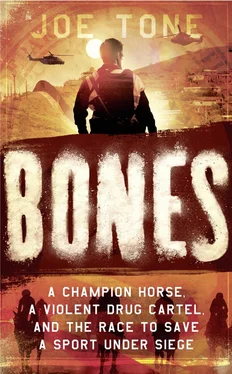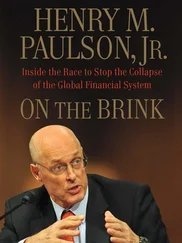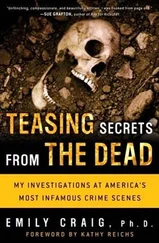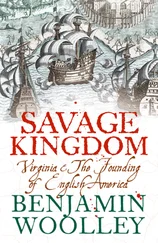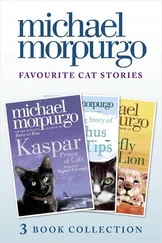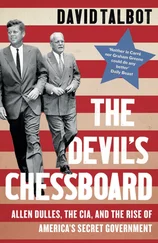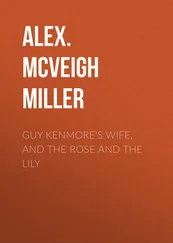Ramiro kept coming, and the money kept coming—eventually. Since Ramiro was a reliable big spender, the auction-house managers didn’t demand that he settle up before he hauled his horses off to Mexico, as they might with lesser-known buyers. They let him take possession of the horses and then pestered him throughout the year to send the balance. So long as he zeroed out his account before the next auction, he remained a valued customer.
Recently, though, Ramiro’s clients had been spending bigger and sending money less reliably. At a small sale in Dallas that summer, he’d spent $112,000 on four yearlings, more money than any other buyer. In two auctions in Oklahoma that fall, he’d spent $370,000 on twenty-eight horses—and then promptly bounced ten checks worth hundreds of thousands of dollars. At one in New Mexico, he’d spent $357,000 on eleven horses. And at another in California, he’d spent $405,000 on seventeen horses. No other buyer came close to spending that much.
The checks eventually cleared; the wires eventually came through. But Ramiro was falling behind, despite spending hours fielding and making phone calls in an effort to settle his debts. The industry was losing patience. Twice recently, sale managers had pushed Ramiro against auction-house walls, demanding he pay off the balance of his bills.
Yet when Ramiro’s hand went up at the next auction, they never told him to lower it. They needed his clients’ money. Today especially. The crowd was thin, which meant sellers would be either giving deep discounts or buying back their horses and waiting for a new day. But Ramiro’s Mexican clients seemed impervious to economic downturns. They wanted more horses, and the best horses, always.
Walking through the barns, Ramiro could get a sense of a horse’s demeanor, its build, its balance, all data points that might influence how high he might be willing to bid. Sometimes he asked one of the handlers to heave open a stall’s sliding door and walk the animal around, so he could see how the horse handled itself in space. But the real data was in the catalog he was holding. Each page was covered in size-nothing type detailing a single horse’s lineage—sire, dam, their sires and dams, and the career highlights of every horse along the line. Wins in “stakes races” were set in a heavier black font, which allowed seasoned buyers to assess the pedigree with a flip of the page. Their eyes were trained to scan for that coveted black type.
Like all buyers, Ramiro was especially interested in a horse’s sire. Like all buyers, he was especially interested if that sire was First Down Dash. A champion racehorse in the 1980s, First Down Dash was the sport’s most prolific breeder, responsible for hundreds of winners and millions in earnings.
The auction house offered two positions from which to bid. One was inside, in the small gallery that circled the sales ring. The other was outside, around the artificial-turf walking ring, where the horses were displayed before being led up a faux-brick walkway and inside. Ramiro liked it outside. There was a bid-spotter out there, looking for flying hands, and it was a good place to get one last glimpse of a horse before the bidding started. Ramiro found his post along the rail and struck his usual pose, his belly flung out in front of him and his sales book resting on top of it.
He started slowly. He placed a bid on a “foal in utero,” an embryo or fetus still developing in the womb. Buying an unborn horse was sort of a blind wager, with big risks and a big upside. Instead of buying on the strength of a horse’s pedigree and conformation—its genetic promise and its physical reality—here Ramiro was betting only on the horse’s lineage. He did it often. He nabbed that first embryo for $1,500, and several horses later, his hand rose on another. This one had been sired by famous First Down Dash, but it was still a long shot, given that the foal could be born with any number of defects, or could just be slow, or could goddamn die on its way into the world. Still, Ramiro bid $13,500 on it.
Ramiro kept on like that, stocking up on quality breedings for relatively cheap. He paid $30,000 for a horse called Bench Mark Dove, $16,500 for Azeann, $6,700 for Beduinos First Down. By the time the auction reached its final hour, he’d spent a little more than $100,000 on seven horses, including some of the sale’s most expensive.
Then the auctioneer called hip number 140, the 140th horse of the auction, its number penned on its hip. A handler walked into the ring beside a sorrel yearling colt. A white racing stripe bisected the horse’s face, falling down the steep angle from brow to nose.
“Tempting Dash,” the auctioneer bellowed. Ramiro’s hand twitched back to life.
The bidding climbed through the low five figures. Ramiro steadily lifted his hand as the other bidders fell away. Maybe it was the horse’s May birthday, which meant he’d be one of the younger two-year-olds on the track the following year. Maybe it was his size; he was small, shorter and skinnier than the prime yearlings, which stood somewere around fourteen hands and weighed 850 pounds. Whatever the reason, Ramiro found himself the last bidder to raise his hand, with the price stuck at $21,500, a meager sum considering Tempting Dash’s lineage.
“Sold,” the auctioneer said, to the ruddy-cheeked fellow in the bright polo with the phone pressed to his ear. Another bargain for his clients back in Mexico.
CHAPTER THREE
FOLLOW KIKO
PIEDRAS NEGRAS, COAHUILA, MEXICO
Summer 2008
I’m here, where are you, are you coming? José was standing outside a gas station one summer evening, talking—and hoping—into his phone. He was in Piedras Negras, a snaking two-hour drive north of Laredo’s Bridge One, where he would soon find himself emptying his pocket trash for a rotating cast of badge-wielding Americans. This was a different crossing point on a different day, but José could expect the same riverside indignities whenever he decided to cross back into Texas, probably in a day or two. For now, though, there was a party to attend.
It was a family affair, thrown by his little brother in rural Coahuila, a Mexican border state about a seven-hour drive from José’s house outside Dallas. Leaving the United States didn’t come with the same harassment, since the Mexican authorities didn’t scrutinize José’s entries as the American ones did. Still, crossing into Mexico could be treacherous for José and people like him.
It was a travel experience unique to the friends, families, and associates of Mexico’s most-wanted criminals. Some American defense lawyers make the trip when they’re invited to off-the-radar meetings, traveling to undisclosed locations to update drug lords on the status of various cases against them, their families, and their organizations. The actor Sean Penn took the trip and made it famous with his 2015 visit to El Chapo—the long, blind journey into the remote Mexican countryside, no cellphones allowed.
José made the trip only occasionally, usually for family gatherings or parties like this one. For baptisms, Mother’s Day, and other occasions—tonight was a nephew’s birthday—his brother Miguel liked to throw the doors open at one of his ranches and invite in people he loved and trusted. He sent out for beer and made sure it was cold, sent out for cabrito and made sure it was perfectly smoked. With a busy family life in Dallas, José didn’t get there often. This time, he made the trek.
After crossing, José found his way to a gas station near the border, where one of his brother’s workers was supposed to pick him up and deliver him to the party. But visiting an extraordinarily wanted criminal is never that simple. José waited there for hours, while his little brother’s men surveilled the gas station to ensure that they didn’t catch a tail—that a Mexican soldier or cop, with an American agent as backup, wasn’t lying in wait, hoping José would lead them to his brother. José kept calling back to the party, calling and calling. I’m here, where are you, are you coming, but they didn’t come for hours.
Читать дальше
